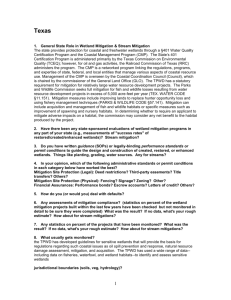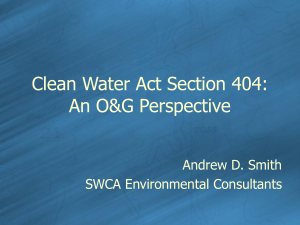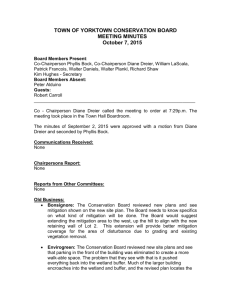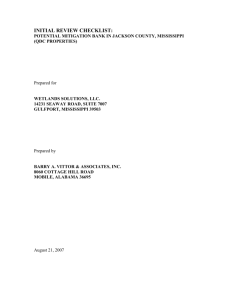Tennessee - Association of State Wetland Managers
advertisement
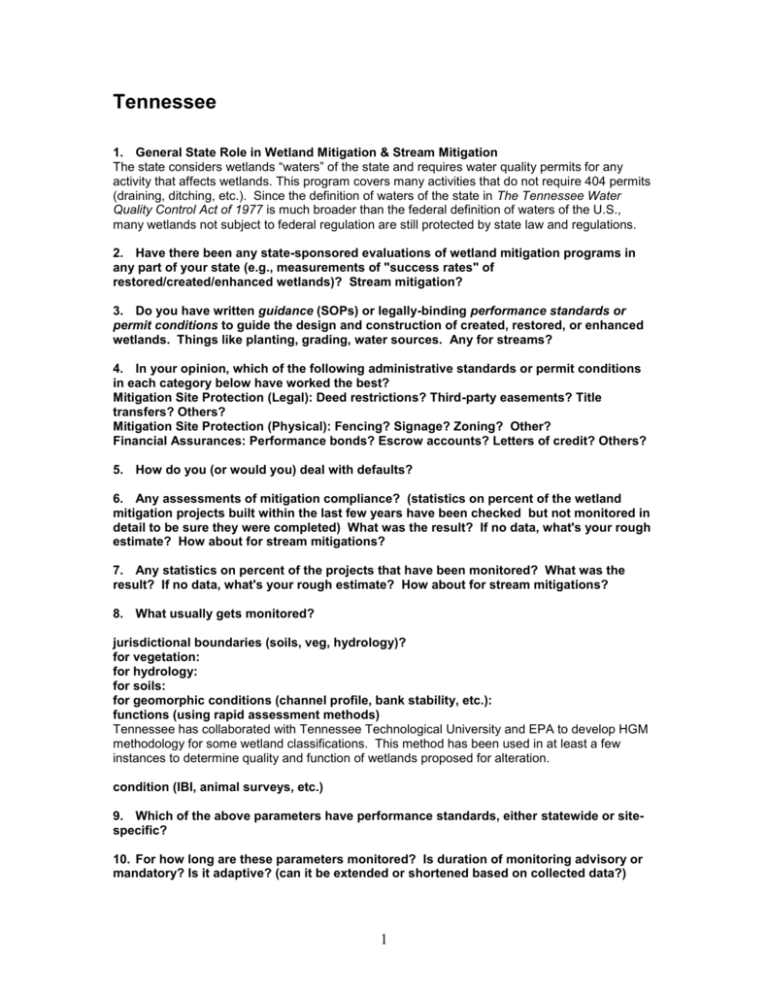
Tennessee 1. General State Role in Wetland Mitigation & Stream Mitigation The state considers wetlands “waters” of the state and requires water quality permits for any activity that affects wetlands. This program covers many activities that do not require 404 permits (draining, ditching, etc.). Since the definition of waters of the state in The Tennessee Water Quality Control Act of 1977 is much broader than the federal definition of waters of the U.S., many wetlands not subject to federal regulation are still protected by state law and regulations. 2. Have there been any state-sponsored evaluations of wetland mitigation programs in any part of your state (e.g., measurements of "success rates" of restored/created/enhanced wetlands)? Stream mitigation? 3. Do you have written guidance (SOPs) or legally-binding performance standards or permit conditions to guide the design and construction of created, restored, or enhanced wetlands. Things like planting, grading, water sources. Any for streams? 4. In your opinion, which of the following administrative standards or permit conditions in each category below have worked the best? Mitigation Site Protection (Legal): Deed restrictions? Third-party easements? Title transfers? Others? Mitigation Site Protection (Physical): Fencing? Signage? Zoning? Other? Financial Assurances: Performance bonds? Escrow accounts? Letters of credit? Others? 5. How do you (or would you) deal with defaults? 6. Any assessments of mitigation compliance? (statistics on percent of the wetland mitigation projects built within the last few years have been checked but not monitored in detail to be sure they were completed) What was the result? If no data, what's your rough estimate? How about for stream mitigations? 7. Any statistics on percent of the projects that have been monitored? What was the result? If no data, what's your rough estimate? How about for stream mitigations? 8. What usually gets monitored? jurisdictional boundaries (soils, veg, hydrology)? for vegetation: for hydrology: for soils: for geomorphic conditions (channel profile, bank stability, etc.): functions (using rapid assessment methods) Tennessee has collaborated with Tennessee Technological University and EPA to develop HGM methodology for some wetland classifications. This method has been used in at least a few instances to determine quality and function of wetlands proposed for alteration. condition (IBI, animal surveys, etc.) 9. Which of the above parameters have performance standards, either statewide or sitespecific? 10. For how long are these parameters monitored? Is duration of monitoring advisory or mandatory? Is it adaptive? (can it be extended or shortened based on collected data?) 1 11. Have there been any legal opinions regarding any of the performance standards or permit conditions? What were the outcomes (which ones are enforceable?) 12. For approximately what percent of the projects was the above data collected BEFORE a site was restored or enhanced? (i.e., baseline data). 13. If no standardized monitoring guidance, who decides what to monitor? e.g., MBRT? 14. Are the construction and monitoring specifications or guidance the same for mitigation bank wetlands as for other mitigation wetlands? Since the mid-1990’s Tennessee has had a wetlands mitigation banking system. There has been much recent activity in the area of mitigation for stream impacts. A statewide Stream Mitigation Program (In Lieu Fee) has been established within the Tennessee Wildlife Resources Foundation, a private, not-for-profit organization. There is also interest in the establishment of private stream mitigation banks. 15. Does the party that designed the mitigation project always do the monitoring? If not, who? 16. Does any state agency keep a wetlands permit ledger, tracking system, or database? What does it track? (data fields) Streams too, or separate? The Division of Water Pollution Control uses an Access database called “Premstat” to track the status of a permit application. Permstat includes other information such as a brief description of the proposed activity, latitude and longitude, and affected stream. With the information that has so far been input, it does not readily produce compilations of permitted acreage lost or gained through mitigation. 17. Is the tracking system easily accessible to the public? If not, what arrangements exist for interagency sharing of raw data or the database? 18. Can the data be displayed automatically on maps? 19. Does the state do any wetland mapping of its own? 20. Have there been any attempts to use wetland delineations (done for 404 permits) to update small areas of existing wetland maps? 21. Have HGM class codes been added to NWI or other wetland maps? 22. Have maps been overlaid with other GIS layers to generate statistical profiles of wetlands in any region or watershed? 23. Contact for state agency wetland mapping/ GIS efforts or permit tracking database? 24. Contact for state transportation department, wetlands mitigation person? 25. Contact for stream impact mitigation program, if separate? 26. Can you send us (1) mitigation performance guidelines or standards? 27. Can you send us (2) case history of a good mitigation project, in terms of administrative and technical performance standards, monitoring, adaptive management, etc.? 28. Can you send us (3) list of data fields in the wetland tracking system (if any)? 2 29. Other contacts suggested? 3



